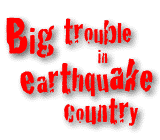
Information
 |
Teacher Information |
|
Time Requirements:
|
Student Skills Required:
|
The purpose of this activity is to aid students in developing a better understanding of the complex nature of the interaction between human beings and earthquakes. This will be accomplished by engaging the students in the use of on-line earthquake hazard maps as well as other relevant seismic information, which they later apply to the assessment and mitigation of threats to life and property associated with hypothetical earthquakes of various magnitudes. Students should be encouraged to work in groups to glean, process, and discuss information pertinent to their particular home or school locations from various public access world-wide-web sites.
Students will find most of the essential challenges and instructions for this on-line activity by accessing the Big Trouble In Earthquake Country Home Page . However, before introducing them to this activity, go through it yourself to determine what you can do to best ensure that their experience is most fruitful. Overall, be sure to encourage discussion throughout the various phases of this activity.
Note: Please direct feedback, questions, comments, or suggestions for this lesson to the author , or to outreach@ssl.berkeley.edu.
![]()
Copyright © 1997 Regents of the University of California